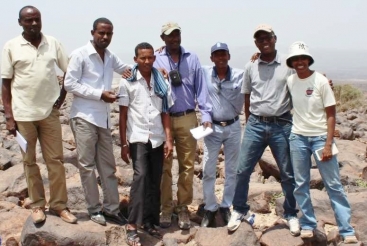
IN FOCUS: Saxon-Bohemian Switzerland in the heart of Europe
A conservation atlas for transboundary conservation areas
Restoration of the Rio Bravo-Grande

The Awash River in Ethiopia drains into a land-locked delta in the arid Afar Region and into a series of fresh water and salt lakes. One of these, Lake Abbè, straddles the border between Ethiopia and Djibouti, and through the Biodiversity Management Programme of the Intergovernmental Authority on Development (IGAD) for the countries in the Horn of Africa, it was agreed that a transboundary conservation landscape (TBCL) needs to be established in the Lower Awash - Lake Abbè area. To get this process going the IUCN office in Nairobi, Kenya, facilitated the appointment of Kevan Zunckel (Co-chair of IUCN WCPA Transboundary Conservation Specialist Group) and Dominique Verdugo (Member of IUCN WCPA Tourism and Protected Areas Specialist Group) to work with the relevant stakeholders from both countries and develop a joint management plan for the area.
Following the principles set out in the WCPA Best Practice Protected Area Guidelines for transboundary conservation, the Diagnostic tool for transboundary conservation planners, developed by WCPA’s Transboundary Conservation Specialist Group, was used to take the stakeholders through a process of systematically assessing if they have a compelling case for the TBCL. It took a full day of hard work to ensure that all the questions were well understood and answered as three-way translation was required, but all the participants contributed positively throughout and thorough discussions had to reach consensus on the answers. Ultimately, the diagnostic tool revealed that there is a compelling case, many opportunities and few risks for this initiative, also providing good insight and information for components of the joint management plan. However, an additional outcome was the shared understanding that was developed and the sense of team work and ownership for the initiative amongst the stakeholders. This made the process of developing the framework for the joint management plan, i.e., a shared vision and prioritised management objectives, relatively straight forward.
The diagnostic tool is therefore a great mechanism to use at any point in a transboundary conservation process and it needs wider application by more practitioners to ensure that it can be fine-tuned and improved. From this process it was noted that the tool needs to be enhanced on aspects of financial sustainability and practitioners are encouraged not to lose sight of this important aspect when looking for that ‘compelling case’.
More information is available from Kevan Zunckel at kevanzunckel@gmail.com.







